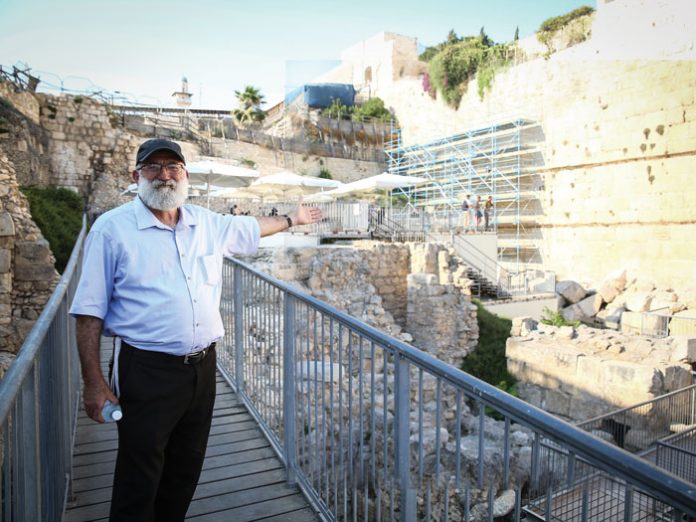“In the western quarters of the enclosure of the Beis Hamikdash,” the historian Titus Flavius Josephus, born Yosef ben Matisyahu, wrote close to 2,000 years ago, “there were four gates. The first led to the king’s palace, and then to a passage over the intermediate valley. Two more led to the suburbs of the city. And the last led to the city proper, where the road descended into the valley by a great number of steps, and then up again by the ascent. For the city of Jerusalem enveloped the Beis Hamikdash in the manner of a theater, which was encompassed with a deep valley along the entire south quarter.”
On this hot July afternoon, my host Mati Dan and I are seated in front of that fourth gate, as the Middle Eastern sun beats down mercilessly on our heads. The remnants of that gate are known today as Robinson’s Arch, named for American researcher Edward Robinson, who identified it in 1838.
Although this area located at the southern end of the Kosel, not too far from the security entrance to the Kosel plaza, is a place of astounding holiness, history and present-day controversy, most visitors pass it by without even knowing that it exists. Few people realize that the Kosel includes the entire western retaining wall of the Har Habayis, and when Chazal said that the Shechinah never left the Kosel Hamaaravi, they meant Robinson’s Arch as well.
The extent of the devastation of the churban is very much in evidence here. The huge stones that were toppled during the siege still lie unnervingly at the foot of the Arch. It is as though the moment of the churban has been captured for posterity.
The destruction of Robinson’s Arch has traditionally been blamed on the Roman legions that destroyed the Beis Hamikdash and eventually set fire to the entire city. More recently, it has been attributed to the zealot factions that had wrested control of the Har Habayis and fortified it prior to its fall. By wrecking the overpass, these zealous defenders made access to the makom haMikdash much more difficult for the besieging forces.
About 20 years ago another type of breach occurred at this site: Israel opened an archaeological park in the area around Robinson’s Gate, and allowed the space to be used for non-Orthodox prayer services. In 2003, Israel’s Supreme Court, while barring the provocative Women of the Wall from reading the Torah or wearing traditional talleisim at the Kosel plaza itself, instructed the Israeli government to prepare the site of Robinson’s Arch to host such services. The site was inaugurated in August 2004, which resulted in the location being referred to as HaKotel Hamasorti, the Conservative Wall, as opposed to the Kotel Hamaaravi.
The court-ordered compromise unnerved not only the Orthodox Jewish community, which viewed it as a blatant desecration of the Kosel, but also the Reform and Women of the Wall activists who considered the location to be unsatisfactory, arguing that its designation as an archaeological site resulted in restrictions on access and worship. They also claimed that their exclusion from the Kosel plaza itself meant that they were “second-class citizens.”
Eric Yoffie, president of the Union for Reform Judaism, expressed their objection this way: “The wall as it’s been understood by the Jewish people does not mean Robinson’s Arch…it just doesn’t.” At the same time, he has never articulated what the wall actually means to people who prefer to call their houses of worship “temples” rather than shuls to signify that they have abandoned the Jewish longing to rebuild the Temple in Jerusalem.
In April 2013, Jewish Agency chairman Nathan Sharansky proposed a solution for resolving the controversy, calling for the renovation of the site to make it accessible to worshippers at all hours of the day. By the end of that August, a new 4,480-square-foot prayer platform had been built next to Robinson’s Arch, with access at all hours.





















